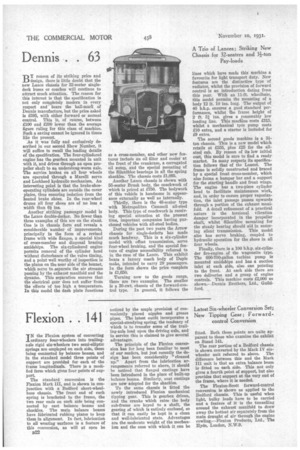Flexion. 141 I N the Flexion system of converting ordinary four-wheelers
Page 12

If you've noticed an error in this article please click here to report it so we can fix it.
into trailingaxle rigid six-wheelers two semi-elliptic springs are employed on each side, these being connected by balance beams, and in the standard model three points of support are provided for each of the frame longitudinal.s. There is a modified form which gives four points of support.
The standard conversion is the Flexion Mark III, and is shown in conjunction with a Bedford short-wheelbase chassis. The front end of each spring is bracketed to the frame, the two rear ends on each side being connected by cast balance beams and shackles. The main balance beams have lubricated rubbing plates to keep them in alignment. In fact, lubrication to all wearing surfaces is a feature of this conversion, as will at once be
noticed by the ample provision of conveniently placed nipples and grease pipes. The latest outfit incorporates a special, steadying spring, the tendency of which is to transfer some of the trailing-axle load upon the driving axle, and in service this is claimed to give several advantages.
The principle of the Flexion conversion has for long been familiar to most of our readers, but just recently the design has been considerably "cleaned up." Apart from the lubrication arrangements referred to above, it should be noticed that flanged castings have been introduced in the place of built-up balance beams. Similarly, neat castings are now adopted for the shackles.
To the same chassis is fitted the newly introduced Flexion mechanical tipping gear. This is gearbox driven, and the cranks which raise the body sub-frame are keyed to a shaft, the gearing of which is entirely enclosed, so that it can easily be kept in a clean and well-lubricated state. Advantages are the moderate weight of the mechanism and the ease with which it can be fitted. Both these points are quite apparent to those who examine the exhibit on Stand 141.
The rear portion of a Bedford chassis is shown converted by the Mark IV sixwheeler unit referred to above. The difference between this and the Mark III unit is that an extra balance beam is fitted on each side. This not only gives a fourth point of support, but also provides that support at the very end of the frame, where it is needed.
The Flexion-Scott forward-control conversion is shown as applied to the Bedford chassis. This is useful when light, bulky loads have to be carried and a feature of it is the tunnelling around the exhaust manifold to draw away the hottest air separately from the main draught of air through the engine cowling.—Flexion Products, Ltd., The Hyde, London, N.W.9.
















































































































































